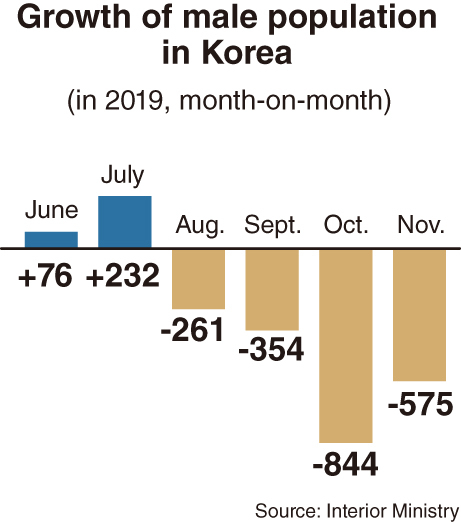[News Focus] Men’s population in Korea falls for 4 consecutive months
Number of Korean men may decline for 1st time on yearly basis in 2019
By Kim Yon-sePublished : Dec. 23, 2019 - 11:58
SEJONG -- South Korea’s sex ratio -- ratio of males to females in a population -- has been showing drastic changes in recent years.
The female population in Korea came to 25.98 million as of November 2019, which is higher than the figure for men by 120,000, according to the data of the Ministry of Interior and Safety.
Women began outstripping men on June 2015, with 25.7157 million female Koreans as against 25.7153 million for males.
The latest data suggests that women, who have longer lifespan than men will continue to widen the gap in population.
During the August-November period, the women’s population increased by 7,849 across the country. The monthly figure for women has yet to show negative growth since the government started compiling the data.
The female population in Korea came to 25.98 million as of November 2019, which is higher than the figure for men by 120,000, according to the data of the Ministry of Interior and Safety.
Women began outstripping men on June 2015, with 25.7157 million female Koreans as against 25.7153 million for males.
The latest data suggests that women, who have longer lifespan than men will continue to widen the gap in population.
During the August-November period, the women’s population increased by 7,849 across the country. The monthly figure for women has yet to show negative growth since the government started compiling the data.

In contrast, male population dropped by 2,034 over the corresponding period. Particularly, this marked the first time that the figure for men fell for the fourth consecutive month.
A demographic analyst pointed out that “the decline in male population has been evident in recent years.” The number of men dropped by 397 in March 2017 from a month earlier, which marked the first time in Korea’s official statistics, though the figure increased again between April and December 2017 each month.
In 2018, the male population fell three times -- in January by 308, in February by 98 and in December by 242, while it rose during the other nine months of the year.
This year, the figure for men climbed six consecutive months from February to July after falling by 611 in January. But the growth posted minus 261 in August, minus 354 in September, minus 844 in October and minus 575 in November.
The analyst raised the possibility that the male population on an annual basis will decline for the first time in 2019. “The figure just inched up 475 during the first 11 months of the year. So the data for December is drawing wide attention.”
The 2019 figure could manage to record a plus, but the negative growth in the number of male Koreans is quite feasible starting from 2020, he added.
In November, 10 of the 17 major areas (eight cities and nine provinces) reported a drop in the number of male residents.
Seoul led the nationwide drop as its number of male residents fell by 2,419 last month, compared to the previous month, to 4.74 million, followed by Busan with minus 1,198 to 1.67 million.

Daegu ranked third with minus 1,111, trailed by Daejeon with minus 793, North Jeolla Province with minus 575, South Gyeongsang Province with minus 335, Gwangju with minus 280 and Ulsan with minus 234.
Interior Ministry data showed that men’s population increases -- of 4,112 in Gyeonggi Province, where many new residential towns have been built, and 1,106 in Sejong, the fastest-growing city in the nation as it was created in 2012 -- have somewhat offset the declines in the 10 regions.
Date showed that the pace of decline in men’s population in Seoul is quite serious. Over the Aug.-Nov. period, the number of male Seoul citizens slid 13,657, compared to the nationwide fall of male Koreans, 2,034.
Demographic data by generation is proving women’s longer lifespan in the nation. The population of men and women in their 70s were 1.6 million and 1.98 million, respectively. Those in their 80s were 560,000 vs. 1.06 million, those in their 90s were 52,000 vs. 177,000 and centenarians were 4,812 vs. 15,290.
The situation is a contrast to the figures of younger generations, in which the number of men currently exceeds women in age groups in their 50s and below. Women’s population outstrips men’s from those in their 60s.
Boys also are outnumbering girls among newborn babies, as scientists claim the slightly higher probability of giving birth to boys than girls on the basis of genetics. Last month, the number of male babies came to 12,355, compared to females at 11,830.
Boys outnumbered girls among newborns in 12 (including Seoul, Gyeonggi Province and Busan) of the 17 major areas. The figures for boys and girls were tied in Ulsan, while four (Sejong, Daejeon, North Gyeongsang Province and Jeju Province) recorded the opposite.
By Kim Yon-se (kys@heraldcorp.com)


![[AtoZ into Korean mind] Humor in Korea: Navigating the line between what's funny and not](http://res.heraldm.com/phpwas/restmb_idxmake.php?idx=644&simg=/content/image/2024/04/22/20240422050642_0.jpg&u=)


![[Herald Interview] Why Toss invited hackers to penetrate its system](http://res.heraldm.com/phpwas/restmb_idxmake.php?idx=644&simg=/content/image/2024/04/22/20240422050569_0.jpg&u=20240422150649)
![[Exclusive] Korean military set to ban iPhones over 'security' concerns](http://res.heraldm.com/phpwas/restmb_idxmake.php?idx=644&simg=/content/image/2024/04/23/20240423050599_0.jpg&u=20240423183955)
![[Graphic News] 77% of young Koreans still financially dependent](http://res.heraldm.com/phpwas/restmb_idxmake.php?idx=644&simg=/content/image/2024/04/22/20240422050762_0.gif&u=)






![[Exclusive] Korean military to ban iPhones over security issues](http://res.heraldm.com/phpwas/restmb_idxmake.php?idx=652&simg=/content/image/2024/04/23/20240423050599_0.jpg&u=20240423183955)



![[Today’s K-pop] Ateez confirms US tour details](http://res.heraldm.com/phpwas/restmb_idxmake.php?idx=642&simg=/content/image/2024/04/23/20240423050700_0.jpg&u=)